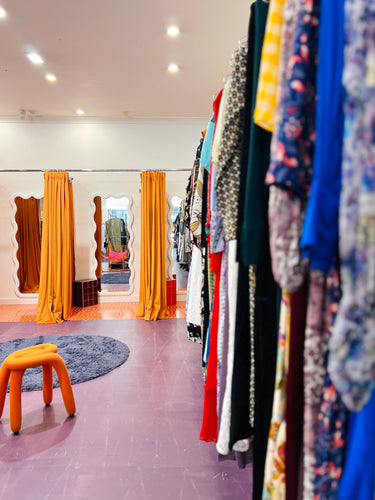What are op shops in Australia?
Op shop is short for opportunity shops, which are shops selling secondhand goods. They are often operated by non profits / charities, but not always. In the US, they are known as thrift stores, thrift shop or consignment stores.
Op shops usually have a permanent indoor structure, so they are different to trash and treasure markets that tend to be one-off outdoor events. Trash and treasure markets are also known as weekend markets in Australia, or flea markets in the US.
Are op shops the same as charity shops?
Yes and no.
The term “op shop” was first coined to describe charity shops selling secondhand goods in the beginning, but as demand for secondhand items like clothes, shoes and handbags increase, people often use it interchangeably with “thrift store” or resale shops in general.
Online thrift stores like SwapUp, for example, are not charities, but some people call us op shops because we sell secondhand clothes.
Do op shops make money?
Of course! As buying and selling secondhand become more mainstream, Australia’s secondhand economy is currently estimated to be worth $46 billion, and op shops (or thrift stores) are one of the players.
Op shops receive donations and volunteers so their costs are quite low. The profit raised through selling donated products supplements direct financial donations to provide social welfare initiatives in their local communities, ranging from disaster relief to refugee assistance. The financial revenue per tonne of clothing is expected to be $1,700.
Salvos operates one of the largest chain of op shops in Australia with 348 stores across the country. According to the Salvos Annual Report 2021, the organisation generates $217 million revenue from trading activities and $52 million profit.
What is op shops' role in circular economy?
According to the MRA Consulting Group's comparative study on clothing donated to charitable enterprises, nationally, about 300,000 tonnes of donated clothing is processed by the charitable reuse and recycling sector per year. On average it equates to 12 kg of clothing textiles donated per person in Australia. Almost all charitable donations accept donations in-store.
Of the clothes received, about 16.5% is sold at a charity shop with 0.4% is provided as welfare. Another 36% of clothing is recycled domestically, 33% is exported and 14% is sent to landfill. Most people are surprised that less than one-fifth of donations are sold. There are many possible reasons for this, including low quality donations (due to the rise of fast fashion) and market inefficiency. The latter is understandable as most retail stores use omni-channels while op shops rely on brick-and-mortar only until very recently.

That being said, op shops' operations are already saving 59% of electricity consumption, 57% of water consumption and a whopping 66% of tonnes of greenhouse gas emissions — compared to an alternative scenario where all clothing textile waste is disposed of to landfills. Imagine how much better it could be if the reuse and recycling sector is commercially bigger, so more clothes can be saved!
Where can you find op shops?
There are 2,700 charity shops and social enterprise reuse centres in Australia. Three quarters of them are in Queensland (28%), NSW (25%), and Victoria (24%) — these three states have at least 600 stores within their jurisdictions. This does not include non-charity consignment shops.
Most suburbs and small town centres in Australia have an op shop run by either the Salvation Army, St. Vincent de Paul Society (colloquially known as Vinnies), Red Cross, and many other charity organisations.
What are the best op shops in Sydney?
Our favourite op shop is the huuuuge Salvos flagship St Peters store in Tempe. Shoppers are immediately greeted by rows of handbags and displays of watches and jewellery as they come in. But these are just the tip of the iceberg — there are thousands more items to browse, ranging from clothing to furniture, books, hobby stuff, and some donated supplies. The staff is always friendly, but this op shop does get busy on the weekends.
This op shop website gives a complete list of op shops in Sydney.
What are the best op shops in Melbourne?
It's hard to pick one because there are so many equally good op shops in Melbourne.
So instead, we'll recommend that you visit everything in Fitzroy area! The bohemian suburb truly lives up to its hype. We scored some pretty great coats and workwear last time (albeit at a higher price than other op shops, around $20-30 apiece) when we conducted our super official reconnaissance last time. It's worth it though.
This article also gives you a pretty good list of specific vintage and thrift stores to explore in Melbourne, if that's your cup of tea.
Don't forget, some of these charity shops have also started an online store. Their prices are comparable to thrift stores as it does take a lot of efforts to list an item online compared to just putting it on a hanger.
Also read:
A Guide to the Best Op Shops & Thrift Stores Around North Sydney
Best Op Shops Across Every Australian State
A Guide to Op Shops Near Melbourne Suburbs





